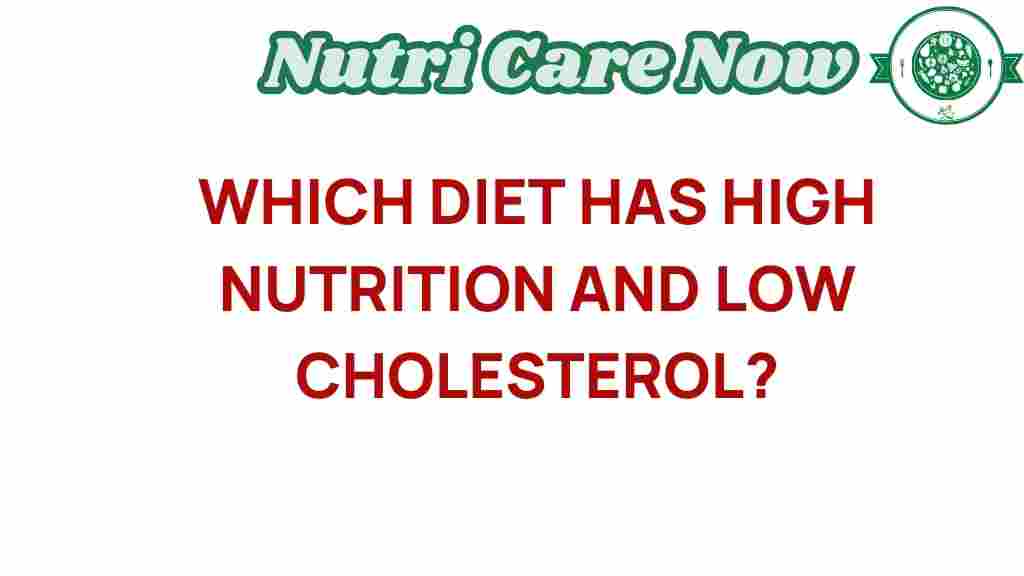Discover the Diet That Balances High Nutrition and Low Cholesterol
In today’s fast-paced world, maintaining a healthy lifestyle can be a challenge. However, adopting a diet that emphasizes high nutrition while keeping cholesterol levels in check is essential for heart health and overall wellness. This article explores effective food choices and dietary guidelines that promote balanced meals, ensuring you enjoy delicious food while taking care of your heart.
Understanding Cholesterol and Its Impact on Heart Health
Cholesterol is a waxy substance found in your blood, and while your body needs it to build healthy cells, high levels can increase your risk of heart disease. There are two types of cholesterol:
- Low-Density Lipoprotein (LDL): Often referred to as “bad” cholesterol, high levels of LDL can lead to plaque buildup in arteries, increasing the risk of heart attack and stroke.
- High-Density Lipoprotein (HDL): Known as “good” cholesterol, HDL helps remove other forms of cholesterol from your bloodstream.
Maintaining a balance between these two types is crucial for heart health. A diet focused on low cholesterol can help manage these levels effectively.
The Importance of Nutrition in a Low Cholesterol Diet
Nutrition plays a pivotal role in maintaining heart health. A diet rich in fruits, vegetables, whole grains, and lean proteins can provide essential nutrients while keeping cholesterol levels low. Here are some key components of a nutritious, low-cholesterol diet:
- Fruits and Vegetables: Packed with vitamins, minerals, and antioxidants, these food choices are low in calories and cholesterol.
- Whole Grains: Foods like oats, brown rice, and whole wheat bread are high in fiber, which can help lower LDL cholesterol.
- Lean Proteins: Sources like fish, chicken, legumes, and nuts provide essential proteins without high saturated fat content.
Steps to Create a Low Cholesterol, High Nutrition Diet
Transitioning to a low cholesterol, high nutrition diet involves making mindful food choices and adopting healthier eating habits. Here’s a step-by-step process to guide you:
Step 1: Educate Yourself on Dietary Guidelines
Familiarize yourself with the Dietary Guidelines for Americans. These guidelines recommend:
- Incorporating a variety of fruits and vegetables into your daily meals.
- Choosing whole grains over refined grains.
- Limiting saturated fats and trans fats.
- Reducing sodium intake.
Step 2: Plan Balanced Meals
Creating balanced meals is crucial for maintaining nutrition. A balanced meal should include:
- Protein: Opt for lean meats, seafood, beans, or tofu.
- Whole Grains: Include quinoa, barley, or whole grain pasta.
- Fruits and Vegetables: Aim for a variety of colors to maximize nutrient intake.
Example of a balanced meal: Grilled salmon served with quinoa and a side of steamed broccoli and carrots.
Step 3: Choose Healthy Fats
Not all fats are bad. Incorporate healthy fats into your diet, such as:
- Olive oil
- Avocados
- Nuts and seeds
- Fatty fish like salmon and mackerel
These healthy fats can help improve heart health while maintaining low cholesterol levels.
Step 4: Be Mindful of Portion Sizes
Portion control is an essential aspect of healthy eating. Using smaller plates, checking serving sizes, and being attentive to hunger cues can help prevent overeating.
Step 5: Incorporate Regular Physical Activity
Physical activity complements a healthy diet. Aim for at least 150 minutes of moderate aerobic exercise each week. Activities can include:
- Brisk walking
- Swimming
- Cycling
- Yoga
Regular exercise helps manage weight, reduces LDL cholesterol, and boosts HDL cholesterol levels.
Food Choices to Embrace and Avoid
Making informed food choices is vital for staying on track with a low cholesterol, high nutrition diet. Here’s a breakdown of what to embrace and what to avoid:
Foods to Embrace
- Fruits: Apples, berries, oranges, bananas
- Vegetables: Spinach, kale, carrots, bell peppers
- Whole grains: Oats, barley, quinoa, whole grain bread
- Lean protein: Skinless chicken, fish, beans, lentils
- Healthy fats: Olive oil, nuts, seeds, avocados
Foods to Avoid
- Saturated fats: Red meats, full-fat dairy products, butter
- Trans fats: Fried foods, commercial baked goods
- Processed foods: Fast food, packaged snacks, sugary beverages
- High-sodium foods: Processed meats, canned soups, salty snacks
Troubleshooting Common Challenges
Transitioning to a low cholesterol, high nutrition diet can present challenges. Here are some common issues and solutions:
Feeling Deprived
It’s common to feel deprived when eliminating favorite foods. Instead of focusing on what you can’t have, explore new recipes and flavors. Experiment with spices and herbs to enhance the taste of healthy meals.
Eating Out
Dining out can pose challenges for healthy eating. Here are tips for making better choices:
- Review the menu ahead of time and look for healthy options.
- Ask for dressings and sauces on the side.
- Choose grilled or baked items over fried foods.
Staying Motivated
Maintaining motivation is key to long-term success. Keep a food journal to track your meals and progress. Celebrate small victories and seek support from friends or groups focused on wellness.
Conclusion
Adopting a diet that balances high nutrition and low cholesterol is essential for heart health and overall wellness. By making informed food choices, following dietary guidelines, and embracing a lifestyle that includes regular physical activity, you can significantly improve your health outcomes. Remember, small changes can lead to significant results over time. Start today by planning your meals, incorporating healthy foods, and prioritizing your heart health. For more tips on healthy eating, visit our wellness page and stay informed!
This article is in the category Diet and created by NutriCareNow Team
